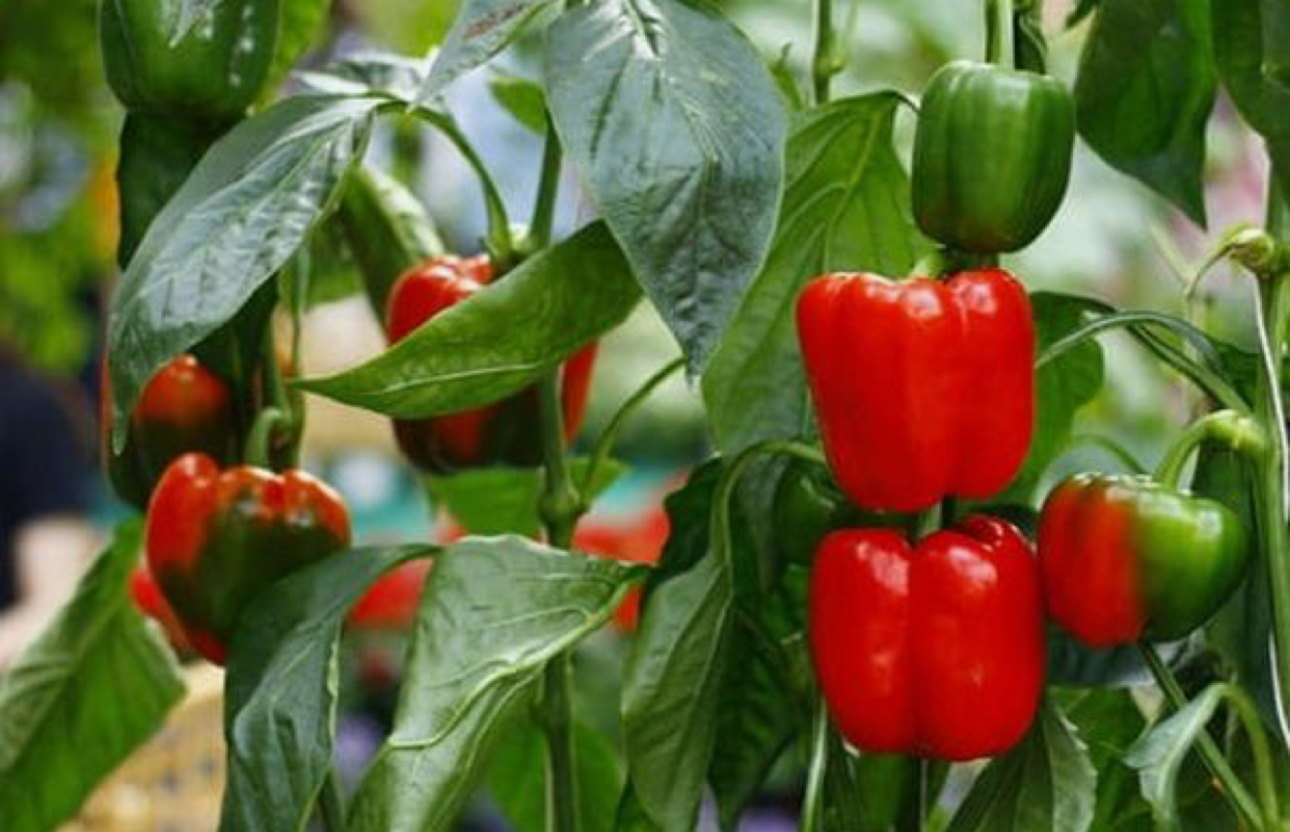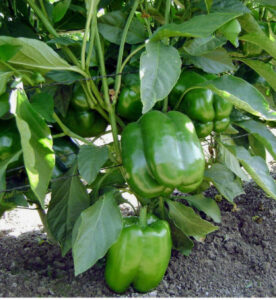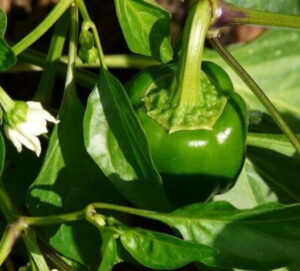
Crazy about Capsicums – October
October 10, 2024
Grow Me Now October 2024
Crazy About Capsicum!
Capsicums, sweet peppers, peppers, and chilli peppers – if you’re confused abot what’s what, you’re not the only one! The plants in this very large family of heat-loving fruiters are all ‘Capsicum Annuum.’ Although the ‘Annuum’ part of their scientific name suggests they are annuals (plants that die after setting fruit and forming seed), Capsicum Annuum are actually perennials (plants that live for several or many years), and the only reason they are considered annuals is that, in colder parts of the world, they cannot survive the chilly conditions that come with winter.
If you live in a colder part of New Zealand, it’s likely that your Capsicum Annum won’t survive winter conditions, even in your tunnel house. If they do survive, they may become so cold-stressed that they fail to thrive once the weather warms up. In which case, you will get better value from your tunnel house if you call it quits on your Capsicum Annum at the end of autumn, and replace them with a useful winter-cropping vegetable. In warmer parts of the country, you may choose to winter-over your Capsicum Annum, and coax them back into full production when the world warms up again in spring. After their first season, however, they may lose vigour.
As for what Capsicum Annum you choose to grow, bear in mind that mild or sweet capsicum (the sort that are not spicy-hot) are usually referred to as ‘bell’ or ‘sweet’ peppers. These Capsicum Annuum all start out life being green but change colour (and become sweeter) with maturity. Mature Capsicum Annuum come in several colours that include red, yellow, orange, brown, and purple. Spicier Capsicum Annuum include a wide range of ‘hot’ or ‘chilli peppers,’ and the heat they exhibit depends on their variety.
For the purposes of this article, we’ll focus on ‘sweet peppers,’ and refer to them simply as ‘capsicum.’ But apart from a few tweaks, all Capsicum Annuum are grown in the same way.
Ground work 200
Warning: Compost, soil, and animal manures can pose a risk to human health. Learn how to work with them carefully before using them in your tunnel-house.
Sowing
The seeds of capsicum can be started in the tunnel house or indoors with the aid of an appropriate germination pad, as early as September. Sow the seed, one per grow-pellet or individual cell filled with commercial seed raising mix, keeping the growing medium damp but not moist.
Transplanting
Once the seedlings are 3-4 cm high, they will need to be transplanted, either into the place you intend them to remain or into a temporary ‘holding container.’ Wherever you keep the young plants, it must be frost-free and preferably at a temperature of between 15 and 18°C.
If you intend planting your capsicums directly into your tunnel house bed, and tunnel house temperatures are warm enough to receive them, now is the time to do so (see bed prep advice below). If temperatures are still cool in the tunnel house, you will need to first transplant your seedlings into individual containers that are three times the width and depth of the cell or grow pellet they currently occupy. If you intend your capsicum to grow throughout the season in a container in your tunnel house, transplant it into a pot or bag that is similar in size to a common household bucket (approximately 9 litres).
In cold or very cool parts of the country, it may be simpler to purchase seedlings from a garden centre. If you do this, check very carefully for signs of pests (such as aphid and whitefly) before buying (don’t hesitate to take a magnifying glass with you to the garden centre for the purpose!).

Preparing the tunnel house
If you intend planting your capsicum directly into a tunnel house bed, you will need to prepare the space ahead of time. To do this, first loosen the ground with a fork, break up any lumps with the back of a rake, and then, with gloved hands, crumble any remaining lumps with your fingers. Stir in one household bucket of mature, safely-made, compost per plant. If the compost does not contain animal manures, add this now in the form of one cup of sterilised pellets (purchased from the garden centre) per plant. Potassium is essential for the plants to produce healthy blooms. If your compost was not made using sea weed or another potassium source, potassium can be applied at a later date as a liquid feed (see below for instructions on how to make this).
Once temperatures in the tunnel house are reliably between 15 and 18°C, the young capsicum plants are ready to go onto the tunnel house for the duration of their lives. If growing in a bed, gently remove the plants from their container by placing your first and second finger around the stem, and tapping gently on the base of the unturned container. Pop the plants into a planting hole in the bed, spacing them approximately 50cm apart (this cspacing an differ according to variety, so check seed packets or plant labels for specific advice).
If your plants are to grow in containers for the duration of their life, they can be spaced out on the floor of the tunnel house in a similar growing shelves to ensure they take up less floor space yet still receive an equal share of light.
Maintenance
If your tunnel house bed was carefully prepared, you should need to water your capsicum plants only once or twice a week, or when the soil is dry to a depth of 4-5cm. Container grown plants will need watering more often than this, as the weather warms up.
At least once a week, the plants can be given 2-3 cups of liquid feed. To make this feed, add all or some of the following to a household bucket of fresh water: chopped comfrey leaves, chopped seaweed, mature, safely-made compost, nettle leaves, sterilised manure pellets. Leave to soak for a week, then strain off and dilute by 50% with fresh water.
Keep a careful pest-watch on your plants. If you spot sap suckers such as aphids or whitefly, use your fingers to gently squash them. If the situation looks like an infestation, spray with a soap and water spray made by dissolving half a teaspoon of hard bathroom soap in 1 litre of hot water. Leave to cool completely before using on the plants. Be sure the spray contacts the insects themselves. Spray the soapy spray onto the ground around the base of the plant, as well, as insects often drop down to this region when their host plant is disturbed. Repeat on a twice weekly basis as necessary.
Keep your tunnel house well ventilated to minimise the risk of fungal disease attacking your capsicum plants, and pick off any leaves at the first sign of disease. As plants become tall, stake and tie as necessary to prevent collapse.
Harvesting
Harvest the peppers, using sharp, clean kitchen scissors, as soon as they are mature. This reduces the energy the plant needs to expend in order to keep the fruit hydrated.

Tips
Water and liquid-feed your capsicum plants from the base only (keep moisture off leaves). This helps keep the plants free of fungal disease, and ensures the fruit stays as clean as possible.
If you are no more that 2/3 of the way through the active growing season, and the plants are growing vigorously but fruit is becoming less plentiful, you may want to consider pruning to help the bush produce more growing points. To do this, use a sterilised pair of secateurs to snip off the upper third to a half of the plant.
In very hot conditions, you may need to cover the Tunnelhouse with shade cloth during the hottest part of the day to prevent the sun blistering the fruit.
